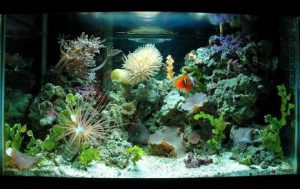In your quest to have a fish only or preferably a reef tank one must consider first the glass cage or tank. I say that establishing a reef tank is preferable to a fish only tank because in my experience fish are healthier in reef tanks than in fish only tanks; also, the diversity of marine life in a reef tank is potentially much greater. In this beginning column I will discuss the tank, where and how to locate it.
Glass or Acrylic cage
Following are various shapes that are available to aquarists today, and any of these tanks can be built into a wall or placed on a stand. Whether you build the stand or build the tank into a wall treatment or have some professional build it for you there are several things to keep in mind:
If the tank is 100-gallons or more it is essential to remember that seawater is very heavy. At about 8-pounds/gallon a hundred gallon tank’s seawater alone weighs over 800-pounds. If the tank is placed on a concrete pad in the basement this is not a problem, but if is located on a wood floor it is important to have the tank’s weight distributed evenly across the floor joists and not run with the floor joists. The idea is to have the weight distributed diagonally across the joists. If that is not possible then it is wise to place a plate with the direction of the joists which are spaced 16-inches center to center from one another. See diagram:
There are three other things to keep in mind concerning location and tank placement:
- Whatever the tank is placed on it is very important the tank stand be level. If the tank is not level excessive pressure develops on the tank seams, whether the tank is glass or acrylic, and could eventually result in a leak or even the tank breaking apart.
- However careful the aquarist is, water will sooner or later get on the flooring, whatever the flooring is made of, and thereby damage the it. Here again it is important to plan for the future and to pay respect to Murphy’s law: whatever can go wrong will and at the worst time.
- Something that marine aquarists often forget: saltwater is very corrosive. It will slowly destroy many materials. It will rust most metals, rot paint and sheet rock due to evaporation. One solution is to prepare for this in advance. One way is to paint the area around the tank with a marine based epoxy paint, especially inside of a holding cabinet. If the tank is set in a wall, where the sump is located behind the tank; the sump room’s walls should be lined with a none corrosive material or at least painted with marine epoxy paint. It is also important to use a ventilation fan if at all possible that will vent the salty air to the outside of the house or apartment. An exhaust fan will also help to dissipate the heat generated by the lighting equipment. This is especially true for reef tank setups.
Tank Shapes
Glass or Acrylic?
If you are preparing to have a reef tank than I strongly recommend that you only consider glass. It is certainly true that glass, compared to acrylic, is much heavier and difficult to drill. And, unless you use starfire glass, it gives the water a feint greenish color in appearance. HOWEVER, coralline algae readily grows on acrylic – it will also grow on glass, starfire or regular glass – and is very, very difficult to scrape off without scratching the plastic, especially in a large deep tank. In my experience, it is virtually impossible to avoid scratching an acrylic tank while removing this calcareous algae. It is possible to scratch a glass tank, but glass is much harder and metal blades can be used to scrape the coralline off of the glass viewing pane without scratching it, not so with acrylic.
The Sump
It is certainly possible to have a successful reef or fish only tank without a sump, but it is harder. It is harder because an organic skin will form on the surface of the tank’s water preventing some light (protons) from reaching the photosynthetic corals, and the over flow or corner box continuously skims water from the surface where it exits to the sump, whether under the tank, a back compartment, or in the room behind the tank. Aside from the sump’s ability to add volume to the system, it is an ideal place to locate equipment that if in the display tank would detract from the natural beauty of the tank. Who wants to see heaters, protein skimmers, refrigeration equipment, calcium reactors, and dosing equipment in or near the display tank. Furthermore, the more volume of water the less affected by small changes to the system, but keep in mind that the larger the system the greater the use of electricity and ultimately the greater cost to the aquarist. Reef tanks are very energy
dependant and this is an issue that the aquarist needs to consider carefully.
Though I have always preferred large man made ecosystems it is certainly possible to have a successful small reef. In fact, one can purchase a complete 10 to 30-gallon setup from various companies. These setups contain everything but the animals.
Following are pictures of my setup, with its two plumbed together 150-gallon Rubbermaid sumps. These Rubbermaid sumps – called stock tanks – come in sizes from 50 to 300-gallons. They make ideal sumps because they are nontoxic, strong and are easy to drill for bulkheads for incoming and outgoing plumbing to the display tank.

One of the two 150-gallon Rubbermaid sumps holding 2 protein skimmers, a calcium reactor, and the heater. The other 150-gallon sump in the back can easily be separated from the system and when necessary be used as a quarantine tank for new animals.
The Nano Reef
Here is the 10-gallon nano reef of Smontanus.
You can read about this nano setup in Advanced Aquarist at, http://www.advancedaquarist.com/2006/5/aquarium
Another Nano reef (only 5-gallons):
The link here is, http://www.advancedaquarist.com/2006/6/aquarium
Two Tips
If you’re setting up a reef tank consider the depth of your tank. Light is especially important to many desirable corals; in particular the colorful acropora. Light loses intensity as it penetrates the water column; therefore, a shallow reef tank is easier and more economical to light. More about this when we deal specifically with light.
When drilling your tank to connect your display tank to its sump be sure to have the bulk head holes big enough to handle future circulation needs. Also, be sure that your sump will not overflow should there be a power outage. With a power outage or a circulation pump failure, the water level in the display tank will drop to the top of the overflow or the location of the return pipes. The return pipes in such a case will change from returns to siphons. Before attempting to put live rock or animals in the new reef tank be sure to thoroughly test the tank by filling it with water and then shut off the return pump. In other words, simulate a power outage or pump failure.
Finally, don’t be in a hurry!




















0 Comments